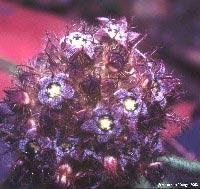Curator Finds, Names New Species of Climbing Milkweed

The climbing milkweed discovered and named by Alexander Krings has tiny, clustered flowers
A new species of climbing milkweed has been named by Alexander Krings, curator of the North Carolina State University Herbarium (also NCSC, its international Index Herbariorum abbreviation). The species – Gonolobus tenuisepalus Krings – was first collected in the tropical rainforests of southern Costa Rica while Krings was a graduate student in the Department of Forestry.
“The flowers are tiny (about 6-8 millimeters in diameter), purplish to dark brownish-red and borne in very dense, umbellate clusters,” said Krings. “Although a number of congenerics occur in Costa Rica, its apparently closest relative is known from Mexico. Based on the mildly fetid fragrance, it is likely pollinated by flies.”
Climbing milkweeds constitute one of the most species-rich and interesting groups of vines in the world. Highly advanced, members exhibit a startling array of highly modified flowers. Pollen is borne in removable sacs called pollinia – a trait that has evolved in only one other plant family: the orchids.
“New discoveries such as this highlight the continued importance of herbaria – collections of dried, pressed, mounted, and labeled plants,” said Krings. All plant species names are governed by an international code of nomenclature. One of the most important requirements of the code is that a physical specimen must be designated for each new species described. This specimen serves as the voucher for the name and is considered the “type” specimen. As each botanical name must be linked to a type, the herbaria of the world maintain literally millions of type-specimens as the basis of all plant names.
Typical of research herbaria, the NC State Herbarium also maintains a collection of type specimens. Founded in 1898, NCSC is maintained by the Department of Botany and serves in a teaching, research, and extension capacity. A brief history, as well as links to its type catalogue, can be found at: http://www.cals.ncsu.edu/botany/ncsc/history.htm.
Media Contact
More Information:
http://www.cals.ncsu.edu/botany/ncsc/history.htmAll latest news from the category: Life Sciences and Chemistry
Articles and reports from the Life Sciences and chemistry area deal with applied and basic research into modern biology, chemistry and human medicine.
Valuable information can be found on a range of life sciences fields including bacteriology, biochemistry, bionics, bioinformatics, biophysics, biotechnology, genetics, geobotany, human biology, marine biology, microbiology, molecular biology, cellular biology, zoology, bioinorganic chemistry, microchemistry and environmental chemistry.
Newest articles
Humans vs Machines—Who’s Better at Recognizing Speech?
Are humans or machines better at recognizing speech? A new study shows that in noisy conditions, current automatic speech recognition (ASR) systems achieve remarkable accuracy and sometimes even surpass human…

Not Lost in Translation: AI Increases Sign Language Recognition Accuracy
Additional data can help differentiate subtle gestures, hand positions, facial expressions The Complexity of Sign Languages Sign languages have been developed by nations around the world to fit the local…

Breaking the Ice: Glacier Melting Alters Arctic Fjord Ecosystems
The regions of the Arctic are particularly vulnerable to climate change. However, there is a lack of comprehensive scientific information about the environmental changes there. Researchers from the Helmholtz Center…



